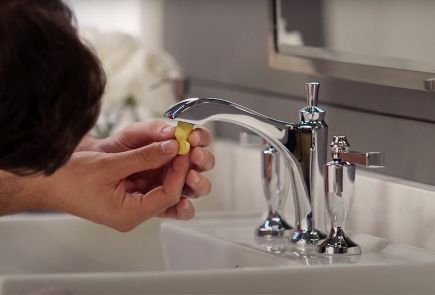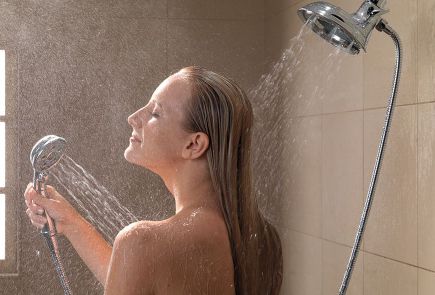We’ve all experienced good showers and bad showers. Remember the fancy hotel with the amazing dancing water and pulsating streams? File that under fantastic shower! How about that weekend trip to your in-laws with their wimpy water pressure and clogged sprays shooting in random directions? File that under never again. If you’ve savored a fantastic shower during your travels, why not bring that experience into your home so you can enjoy it every day? The engineers at Delta Faucet have created innovations to ensure that your showering experience is one to remember.
Installing a new shower head is one of the easiest and cost-effective updates you can make to your bathroom. If your shower head hasn’t been updated in a while, the reduced flow rate of modern shower heads might come as a surprise. Although federally mandated water saving measures have reduced the amount of water flowing per minute, you’ll be thrilled with recent innovations that allow you to personalize your showering experience (hello, massage setting!). In the past few years, shower head technology has undergone many improvements, including the introduction of Brilliance Finishes, Touch-Clean Spray Holes and Temp2O Technology. Understanding the mandated regulations on contemporary shower heads will help provide you the information you need to select the right model for your home.
Flow Rate Restrictions
Since 1994, federal regulations have limited shower head manufacturers to a maximum flow rate of 2.5 gallons per minute (gpm). California has enacted its own legislation limiting the flow rate to 2.0, which will be reduced even further, to 1.8 gpm, in July 2018. Water flow regulations save billions of gallons of water each year while the latest technologies help preserve or even enhance your shower experience. There’s no need to suffer a substandard showering experience just because of regulations.
The engineers at Delta Faucet believe that environmentally friendly design shouldn’t compromise optimal performance. Before the restrictions, shower heads typically used 5.5 gpm. Restricting the flow to 2.5 gpm led to a new generation of water-saving shower heads. The change in flow rate is particularly noticeable if you go from a shower head produced before 1994 to a modern model. With consumer satisfaction in mind and knowing how important a good showering experience is to customers, the Delta Faucet engineers got to work.
Opportunity for Innovation
The new shower flow rates presented a challenge: how to create the best showering experience possible despite the restrictions and limitations of individual homes. What is commonly referred to as water pressure is determined by an individual home’s water system, pipes, location and other elements. The goal became to create shower heads that provide the best shower experience possible, regardless of external factors.
Concurrently, shower heads had begun transitioning from basic functionality to personalized performance. New shower heads were created with multiple spray settings and Touch-Clean rubber spray holes that allow for cleaning with the touch of a finger. Beautiful design and modern styles that coordinate with other bathroom hardware were also developed to ensure that aesthetics match functionality.
In2ition and H2Okinetic Technology
A vital element to any great shower is warmth, so the H2Okinetic spray option was created to sculpt water into a unique wave pattern that gives you three times the coverage of a standard shower head*. This technology was incorporated into other innovations, including the Delta In2ition Two-in-One Shower, which features a combination shower head and hand shower. You can choose to have water streaming from the shower head or handheld sprayer only, or both at once. This innovation allows you to direct the flow of water and manually control where it goes. The combination of these technologies ensures that you don’t have to give up a warm shower to experience the flexibility of a hand shower.
The flow of water meets the requirements of the U.S. Environmental Protection Agency (EPA) while an internal system controls the speed, movement and droplet size of the water. This means that every drop of warm, moving water that hits your body is crafted to give you the best showering experience possible. The high-velocity wave pattern creates the feeling of a warmer, more drenching shower without using more water. Many of the In2ition H2Okinetic shower heads qualify for WaterSense labeling because they save a considerable amount of water.
Good Sense with WaterSense
Showering accounts for nearly 17 percent of residential indoor water use, or about 40 gallons per day for the average family, according to the EPA. That means an estimated 1.2 trillion gallons of water are used for showering annually in the United States. Standard shower heads use 2.5 gpm, but to earn the WaterSense label, a product must use no more than 2 gpm and still meet strict performance requirements. The EPA estimates that the average family could save 2,900 gallons of water per year by installing a WaterSense-labeled shower head. To estimate how much water you’ll save with a WaterSense-labeled product, try this calculator.
Ready for a multisetting, raincan or simply more modern shower head? Many stylish options and finishes are available. If you’re looking for excellent coverage and warmth, consider a Delta In2ition H2Okinetic shower head. If you like the design of a modern raincan shower head but also want the option of a traditional shower head spray, consider a HydroRain 2-in-1 Shower Head. No matter what style you choose, we want you to have an optimal showering experience. If you have questions or concerns about the flow rate of your shower head, reach out to our customer service team to help guide you toward a choice that will deliver a showering experience you’ll love every day. You can reach us online or by calling the Delta Help Line at 1-800-345-DELTA (3358).
*Coverage measured in accordance with EPA WaterSense Specification for shower heads, March 4, 2010.
 See Innovations
See Innovations Get Inspired
Get Inspired View Design Experiences
View Design Experiences Find Parts & Identify Your Products
Find Parts & Identify Your Products Help Center
Help Center Register Your Product
Register Your Product Learn More About Delta Recertified
Learn More About Delta Recertified



.jpg)





















